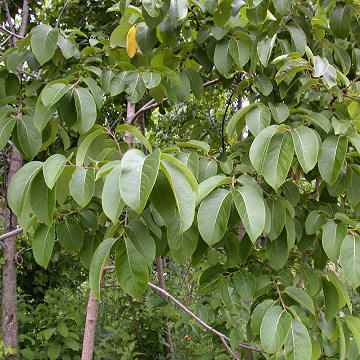

Diospyros virginiana - (image 1 of 7)
Taxonomy
Family: Ebenaceae (Ebony Family)
Habitat
Dry woods, abandoned fields, fence rows.
Associates
Distribution
Southeast CT and southern NY south to FL, west to IA, KS, and TX. Escaped further north and hardy to USDA Zone 4.
Morphology
Deciduous tree to 15 m, sometimes forming colonies; bark hard, thick, dark gray-black, deeply furrowed in distinctive square, scaly blocks. Leaves oval or oblong, 8-15 cm, shortly acuminate; petioles 1-2 cm. Dioecious or nearly so; flowers white to greenish-yellow, 4-merous, corolla urceolate, the lobes spreading; staminate flowers solitary or in groups of 2-3, 1 cm; anthers usually 16, about as long as the corolla tube; pistillate flowers solitary, 1.5-2 cm, with a larger, persistent calyx and usually 8 sterile anthers. Fruit a yellowish-brown to pale orange berry, 2-4 cm; seeds 1-8.
Notes
Flowers late May to June
Wetland indicator: Facultative
The corolla of the flowers in these images have turned brown but are normally white or greenish and fragrant. The fruit is very astringent but purportedly edible after frost. Horses have died after eating the fruit; they can cause gastric obstruction of the small intestine in humans if eaten in quantity. The wood is heavy and close-grained, and has been used to make the head of golf clubs.
References
Dirr, Michael A. 1998. Manual of Woody Landscape Plants:
Their Identification, Ornamental Characteristics, Culture, Propagation and Uses.
5th ed. Champaign, Illiois: Stipes Publishing L.L.C.
Gleason, Henry A.
and A. Cronquist. 1991. Manual of Vascular Plants of Northeastern United States
and Adjacent Canada. Second Ed.
The New York Botanical Garden. Bronx, NY
USDA, NRCS. 2002.
The PLANTS Database, Version 3.5 (http://plants.usda.gov).
National Plant Data Center, Baton Rouge, LA 70874-4490 USA.
|
Michael Hough © 2009 |